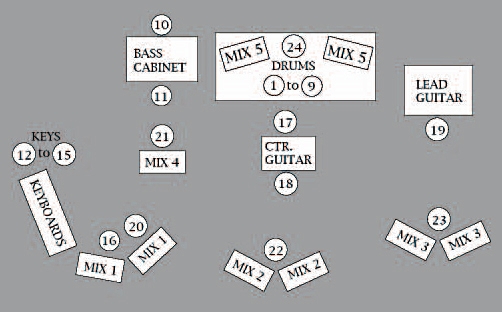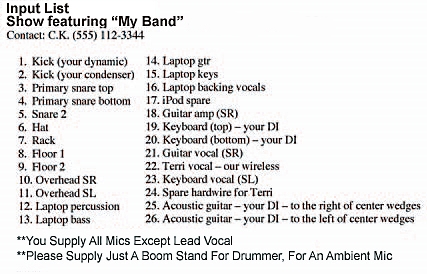Before handling tour and production management for bands, I worked in various venues as a sound tech. I got really sick of crews coming in, looking at the stage plot and input list we had for them, and saying, “Oh, the agent sent you the wrong one!”
So, in other words, they didn’t have five minutes in the last month to call up and make sure that we had the right one.
I used to patch the stage before they got there, hoping to get a head start on sound check, but eventually, I got out of the habit of doing that because so often it needed to be re-done.
This made me want to be the person walking into a venue, with the local guy skeptically asking, “Is this the right input list?” And I glance at it and answer, without breaking stride,“Yes, it is.”
There are a few ways I’ve developed to ensure that I get what I want for my clients.
A few years ago, I made a new backline sheet, input list, and stage plot for a band I was touring with. The plot was faxed to the agent’s office, and the input list and backline sheet e-mailed to his administrative assistant. I requested, specifically, that she destroy all other previous versions in her possession.
However, I discovered shortly after that there is another task to perform – rewriting the basic tech rider that goes out with the contract.
I confess that I’d never really looked at it since taking over from the previous tour manager; rather, I just talked to personnel at venues and sound companies ahead of time, worked out agreements as to what would be supplied for us, and never had any problems.
When it came time to advance one particular show, the owner of the sound company supplying it said, “It’s going to be really expensive to sub-rent a Midas console for you.”

I asked him what he meant and he said the band’s tech rider specifically insists on Midas or Yamaha for FOH and he offered Crest only. I assured him that a Crest console would be just fine. More recently, I walked up to a monitor tech at a show, who asked me if a t.c. electronic unit would be O.K. for reverb in the monitors.
“We don’t use reverb in the monitors,” I replied.
“Well, your rider says you do,” he responded.
I guess I really do need to rewrite that thing!
From working in different venues, I’ve seen some ludicrous demands, including one from a band that shall remain nameless, asking for half a dozen Focusrite compressors.
Another thing that has always amused me is a rider that ask for a given number of watts of amplifier power per audience member, in relation to the room’s capacity. You don’t see so many of them nowadays, but they were once quite prevalent.

What does that mean, really? What if there’s a bunch of big amps blowing at an assortment of crappy cabinets? What if the cabinets aren’t aimed correctly, so there is tons of power, but it’s banging off the walls and ceiling?
Sound companies can sometimes nitpick you to death. I used to mix a band of women whose drummer had grown up steeped in the East Bay funk exemplified by Tower of Power. She liked a ton of kick in her monitor.
Many sound companies and venues automatically provide a drum fill that includes a sub, but we went to play an outdoor festival at a beautiful site in rural Northern California, where many of the other acts on the bill were quieter.














